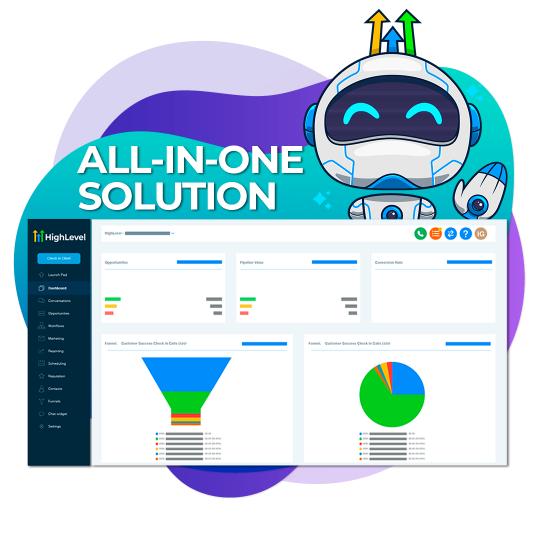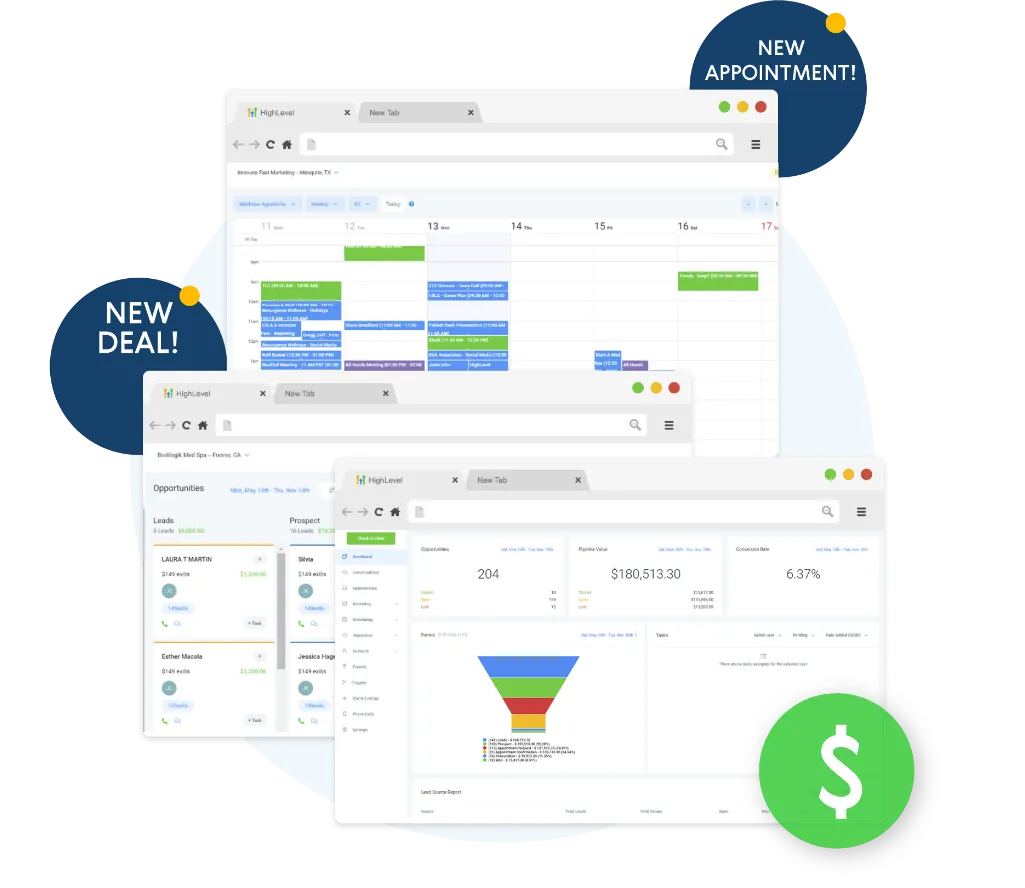Let's make your CRM work like magic, step by step.
First, draw a map of how your customers find you and work with you. Look for the big moments when you talk to them.
Next, set up simple rules that make things happen on their own. Think of them like a game of "if this, then that." When something happens, your CRM knows what to do next.
Connect your CRM to other tools you use. This helps all your tools share info and work together.
Watch how well things are working. Ask your team what they think. Make the system better based on what you learn.
Keep your system ready to grow. Look at your data and fix what isn't working well.
When you do these things, your CRM will feel like it's doing magic on its own.
Feeling overwhelmed by missed leads and disorganized workflows?
Discover the award-winning platform that automates follow-ups, tracks every lead, and keeps your business running smoothly—all in one place. Thousands of businesses are already transforming their sales and marketing with this trusted solution. Don’t miss out—start your 14-day free trial today and click now to uncover exclusive, limited-time special offers!
Understanding CRM Workflow Fundamentals

We want our CRM system to help us work better with customers. First, we need to know what we want to fix. This could be making sales easier or helping new customers get started.
Think of your workflow like a map. It shows what needs to happen first, then second, and so on. When one thing happens, it makes other things start. Like when a new customer signs up, they get a welcome email.
Make sure each person knows their job. Set times for when things need to get done. Track how well things are working by counting what matters most.
Look ahead as you set up your tools. Pick ones that can grow as your team gets bigger. This way, your work stays smooth even when more people join.
Mapping Your Customer Journey
We want to help you make customers happy. First, find all the places where people talk to your business. This means your website, social media, and when they meet you face to face.
Watch how your customers make choices. Look at what they do, how they feel, and what makes them upset. Keep track of these things.
Once you know their needs, you can make better ways to help them. This lets you give them what they want at the right time.
Identify Key Touchpoints First
Your customers meet your brand in many ways. Let's make sure we catch each one so we can help them better.
Think about all the ways people talk to your brand:
- When they visit your website
- When they get your emails
- When they see you on social media
- When they talk to your sales team
- When they need help
Here's what happens at each stop:
| Where They Meet You | What They Do | What You Do |
|---|---|---|
| Website | Look at products | Watch what they like |
| Get welcome notes | Send more info | |
| Social Media | Leave comments | Write back |
| Sales Call | Talk about needs | Write down what they say |
| Help Desk | Ask for help | Fix and check in later |
Look at how people move from first finding you to buying from you. Write down what they do and how they feel at each step. This will help you make their trip smoother.
Map Decision-Making Patterns
We look at how people make choices when they shop with us. This helps us see what they do at each step. When we draw it out, we see where they need help the most.
First, we get to know our shoppers. We learn what they want and what bugs them. This helps us make better maps.
Next, we write down what people do when they visit us:
- What they feel
- Where they go
- How they act
Then, we use smart tools to help them faster. These tools give each person what they need right away.
We look at what works and what doesn't. We check our data often to make sure we help people the way they want. As people change, we change too.
This simple plan helps us give better service to everyone who shops with us.
Ready to simplify your business operations?
Streamline your workflows and boost productivity with a CRM designed to save you time and effort. From tracking leads to automating follow-ups, this platform does it all. Discover what’s possible—learn more about how it works and see why so many businesses rely on it every day.
Designing Trigger-Based Automation Systems

Let's break down how to make things happen on their own. Think about what needs to happen first. Like pushing a big red button! When you push it, other things start to work.
Draw a simple map of what happens first, then second, and so on. Make sure each step makes sense and helps your customers.
Keep it simple – when this happens, that happens next. It's like a line of dominos falling one after the other. Each push moves your customer closer to buying what you sell.
Smart Trigger Chain Design
Trigger chains help your work flow better. Think of them like dominoes – when one falls, it makes the next one fall too. This is how smart triggers work in your business.
First, pick what starts your chain. This could be when someone fills out a form or updates their info. Make sure these match what you need done.
Next, make simple yes/no paths. Like a fork in the road, these paths tell your system which way to go. It could be based on things like:
- Is this person a customer?
- Did they buy something?
- Are they new?
Last, watch how your chains work. Fix any parts that get stuck or don't work right.
Keep your chains neat by putting them in folders. Test them often to make sure they still work well.
Tips:
- Start with basic triggers
- Add simple paths
- Watch and fix problems
This way, your work gets done on its own, just the way you want it.
Action-Response Flow Mapping
Let's make your tasks work smoothly! Think about when you talk to customers. What makes you want to take action? Write these moments down.
Keep an eye on what your customers do. When they buy something or ask for help, you'll want to do something right away. You can send them a nice email or update their info.
Make rules that work for you. Maybe you want to send a thank you note when someone buys from you. Or call them on their birthday. Your computer can help you do this.
Pick the best ways to reach out. You might use email, phone calls, or text messages. Your tools can talk to each other to make this easy.
Think about what works best for each customer. Use what you know about them to make your messages feel special. This way, they'll know you care.
Still struggling to keep your business organized?
Take the guesswork out of managing leads and follow-ups with a platform trusted by thousands of businesses. Say goodbye to missed opportunities and hello to a seamless sales process. Act now—try it free for 14 days and discover how easy it is to stay on top of your workflow. Don’t wait—exclusive offers won’t last long!
Smart Workflow Integration Strategies
Making your work flow better is all about using simple steps that work together. Think of it like building blocks that help your tools talk to each other.
When something happens – like getting a new customer – your system should spring into action. It's like setting up dominos that fall one after another. Each move makes the next one happen.
To make this work:
- Link your main tool to other tools you use. They can then share info without you doing extra work.
- Make rules that send the right emails to people based on what they do.
- Check how well things are working and fix any problems you see.
Your tools can learn from what works best and get smarter over time. Keep testing new ways to make things run smoother. This helps you spend less time on boring tasks and more time helping customers.
Building Scalable Workflow Architecture

Let's make your work smoother as your team grows.
Think of building blocks – you can move them around and change them without breaking everything else.
Pick a CRM that lives in the cloud and can grow with you. Start small.
First, make the daily tasks easier, like talking to new leads and helping new customers get started.
Make sure you can change things easily when you need to.
Look at how well things work every few months.
Write down what you do.
Help your team learn the right way to use the tools.
Watch the numbers to see what's working.
When you spot ways to do better, make those changes.
Struggling to keep up with your growing business?
Simplify your processes and stay ahead with a CRM that adapts to your needs. Manage leads, automate tasks, and focus on what matters most—growing your business. Take the first step—explore the features today and see how it can transform the way you work.
Implementing Real-Time Response Mechanisms
We want to help customers right away when they need us. This helps keep them happy and coming back.
Think of it like having friendly helpers ready to talk to customers at any time. We use simple tools like chat boxes and smart computer programs to give fast help.
Here's what we do:
- Create clear steps so every customer gets help fast.
- Watch how quickly we help people and learn what works best.
- Use smart tech to spot problems early and fix them before customers notice.
The better we're at quick help, the happier our customers will be.
We keep learning what each customer likes so we can give them the best care.
Measuring Workflow Performance

Let's check if our work is helping our customers. We need to look at simple things like how much it costs to get new customers and how happy they're with us.
Pick a few key numbers to watch that match what your business needs. Look at how many leads turn into sales. See how fast your team responds to customers. Ask customers if they like your service through quick surveys.
Look at both numbers (like time saved) and what your team says about the work.
Keep checking these numbers often. This will help you make smart choices to make your work better, keep customers happy, and grow your business.
Future-Proofing Your CRM Workflows
Let's make your CRM work better today and tomorrow.
Your system needs to grow with your business. Think of it like a plant that needs room to get bigger.
Here's how to make that happen:
- Use online CRM tools that play nice with other software. This helps you add new tools when you need them.
- Let smart computers help do the work. They learn as they go and can handle more tasks over time.
- Make a plan to check and fix your system often. Ask your team what works and what doesn't. Keep your tools up to date.
Pick tools that let you pay for what you use. This way, you can use more or less as your needs change. Your work won't stop when you make changes.
Tips:
- Keep it simple
- Check it often
- Listen to your team
- Fix problems fast
Conclusion
We can make your CRM work like magic without the hard stuff. Think of it like a helpful friend who does tasks for you. When something happens, your CRM knows what to do next. It works fast but stays simple. Your team will love how easy it is to use. As you use it more, you can make it better. Watch how it works and fix any problems. The best part? It saves time but still lets people be people.








